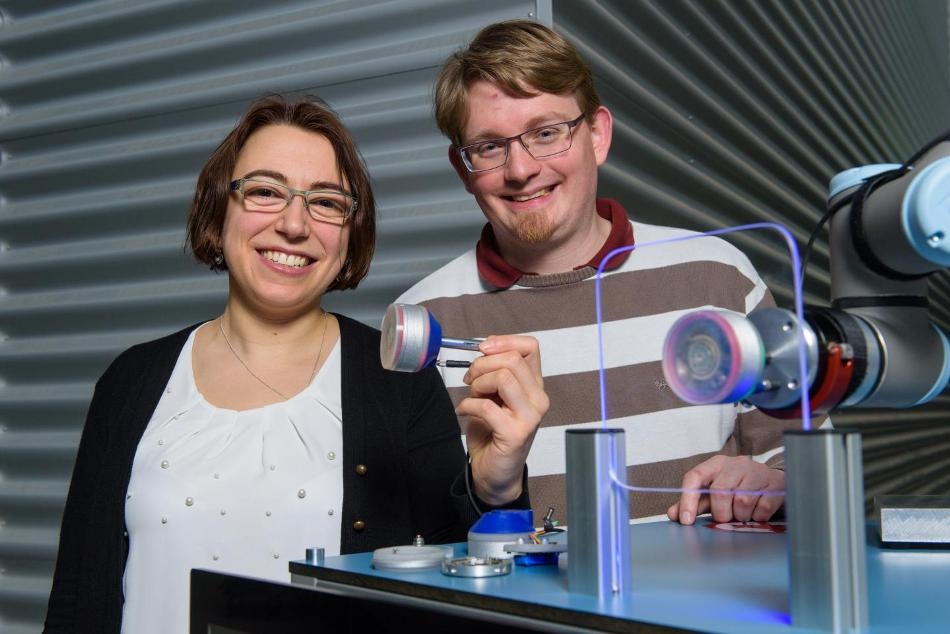Mar 29 2018
A powerful vacuum can be generated and released in the blink of an eye by applying just a short electric pulse. An innovative vacuum gripper designed by a research group headed by Professor Stefan Seelecke from Saarland University allows robot arms to grasp and take objects and move them around freely in space.
The system avoids the need for compressed air to generate the vacuum and is silent, energy efficient, and appropriate for use in clean rooms. Experts in the field of intelligent materials systems use artificial muscles—bundles of ultrafine shape-memory wires with the ability to tense and relax quite similar to real muscle fibers. The wires also act as sensors and can sense, for instance, when the gripper has to tighten or re-adjust its grip.
 Susanne-Marie Kirsch and her research colleague Felix Welsch (r.) are research assistants within the group led by Stefan Seelecke and are developing and optimizing the vacuum gripper technology. (Image credit: Oliver Dietze)
Susanne-Marie Kirsch and her research colleague Felix Welsch (r.) are research assistants within the group led by Stefan Seelecke and are developing and optimizing the vacuum gripper technology. (Image credit: Oliver Dietze)
Between April 23 and 27, 2018, the engineering group from Saarbrücken will take part in Hannover Messe to demonstrate the abilities of their vacuum grippers at the Saarland Research and Innovation Stand (Hall 2, Stand B46). The researchers are seeking industrial partners with whom they can advance their system for specific practical applications.
Being common tools in industrial production lines, vacuum grippers are used to sort, hold, and convey smooth and comparatively flat objects to enable assembly of components, painting of surfaces, or driving in screws. Vacuum grippers are generally too noisy to be used. Compressed air is commonly used in most of the systems, making them loud and also mandating the use of heavy ancillary equipment, and in turn, increasing the costs and rendering the entire system rather inflexible. Moreover, they also use large amounts of energy.
The scenario is absolutely different while considering the new vacuum technology developed by Professor Stefan Seelecke of Saarland University and the Center for Mechatronics and Automation Technology in Saarbrücken (ZeMA). The shape-memory vacuum gripper has the ability to generate a powerful vacuum by using just a robot arm to guide it into position. No additional pneumatic or electric drive system is used.
It is cost-effective, adaptable, and lightweight to produce and runs without noise. It just required electric current, or to be precise, it requires small pulses of electric current—one to produce the vacuum and one to release it. The gripper avoids the need for additional electric power supply while it holds an object, even if the object must be held for a long time or if it must be held at an angle.
The technology is reliant on nickel-titanium alloy’s shape-memory characteristics. “The term ‘shape memory’ refers to the fact that the material is able to ‘remember’ its shape and to return to that original shape after it has been deformed. If electric current flows through a wire made from this alloy, the wire becomes warmer and its lattice structure transforms in such a way that the wire shortens in length. If the current ceases, the wire cools down and lengthens again,” stated Stefan Seelecke, while elucidating on the significant underlying material phase transitions.
Hence, the ultrafine wires contract and relax similar to muscle fibers, based on whether or not an electric current flows. “These shape memory wires have the highest energy density of all known drive mechanisms, which enables them to perform powerful movements in restricted spaces,” explained Seelecke.
In order to develop the vacuum gripper, the scientists arranged bundles of these fibers like a circular muscle around a thin metal disk with the ability to flip up or down, similar to a frog clicker toy. When an electrical pulse is applied, the wires in the “muscle” get contracted and the position of the disk is flipped. If a rubber membrane attached to the disk is placed onto a flat smooth surface, upon flip in the position of the disk, the membrane is pulled on, producing a powerful and stable vacuum. The motion resulting due to the bundling of the wires together is very rapid as well as strong.
Multiple ultrathin wires provide a large surface area through which they can transfer heat, which means they can cool down very swiftly. As a result, the bundle of fibers can shorten and lengthen rapidly, making it possible for the gripper to grab or release an object very quickly.
Susanne-Marie Kirsch
Kirsch and Felix Welsch, her research colleague, are research assistants within the team and are advancing and optimizing the vacuum gripper technology as part of their doctoral research studies.
Currently, the gripper is able to securely hold objects weighing several kilograms. The gripper’s lifting capacity is scalable, with correspondingly more wires being used in large grippers.
Felix Welsch
Moreover, due to the sensory properties of the material using which the wires are made, the vacuum gripper itself becomes aware if the object is not held securely.
The wires provide all the necessary information. The electrical resistance data correlates precisely with the extent of deformation of the wires. By interpreting the measurement data, the controller unit, therefore, knows the exact position of the wires at any one time.
Professor Seelecke
Thus, the gripper has an autonomous way of ascertaining whether or not its vacuum is adequately stable for the current task. It can also send out warnings if a material fatigue or malfunction occurs.